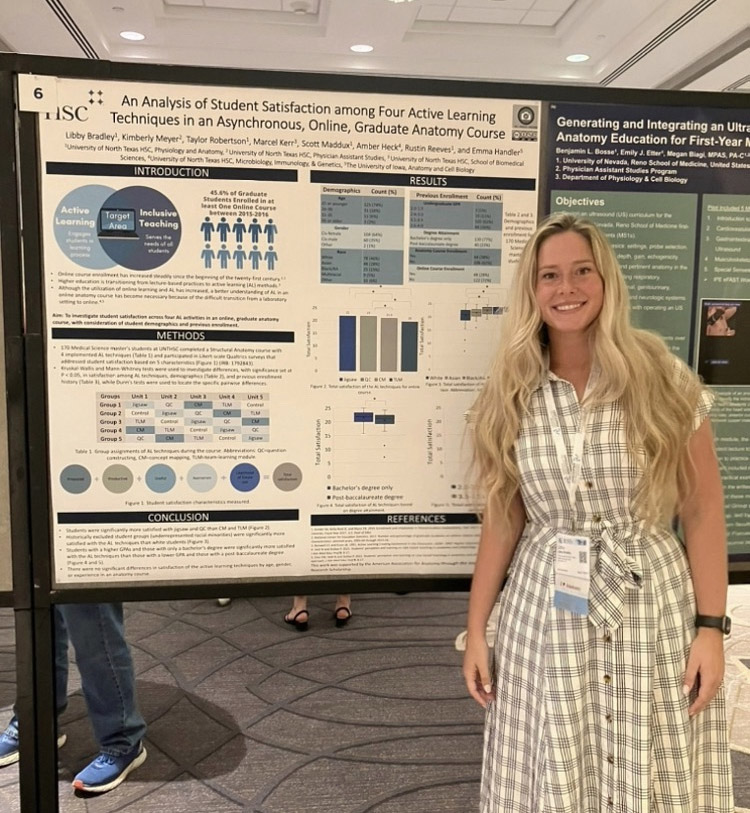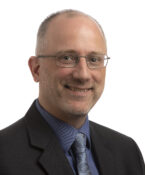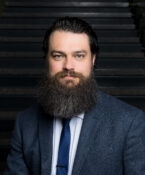SBS graduate is innovating online education
- May 19, 2023
- By: Matt Havlik
- Research
 When the COVID-19 pandemic hit and schools were forced online, many teachers and students were forced to navigate a new world of virtual learning. While classrooms are open again, enrollment in online courses continues to grow. Despite the popularity of virtual learning, research is scarce on how best to teach complex, visually driven courses online.
When the COVID-19 pandemic hit and schools were forced online, many teachers and students were forced to navigate a new world of virtual learning. While classrooms are open again, enrollment in online courses continues to grow. Despite the popularity of virtual learning, research is scarce on how best to teach complex, visually driven courses online.
“We have 45% of graduate students in the United States now enrolled in online courses,” said Libby Bradley, PhD, School of Biomedical Sciences graduate. “That is a huge population.”
“We need to figure out what we can do to help those students really get into their coursework, understand it and actively participate in it.”
While completing her PhD in Biomedical Sciences at The University of North Texas Health Science at Fort Worth, Bradley explored innovative ways to make it easier for students to learn complex and visual topics like anatomy online. Her research suggests that using active learning techniques can improve outcomes and satisfaction rates for online learners.
“Anatomy is such a specific course,” she said. “There is a high volume of information, and it is very difficult to conceptualize online what a human donor looks like. Previous research has indicated that active learning helps in other courses, but there has been very little research on teaching anatomy online.”
Her findings could help improve online courses for students who learn best through collaboration with peers. It could also expand access to health care education to underrepresented and first-generation students.
Active learning includes teaching techniques that allow students to actively participate in their own learning. Under the mentorship of Rustin Reeves, PhD, professor of Physiology and Anatomy and director of the Center for Anatomical Sciences at HSC, Bradley worked with SBS’ M.S. in Medical Science program to test active learning methods in online anatomy courses.
“Any activity that can boost student understanding and retention of difficult concepts in medical education is a plus,” Reeves said.
“We are always looking for better and more effective ways to teach students, and this just proves that active vs. passive learning is a major improvement for the learning process.”
Bradley tested several cooperative peer teaching techniques, including one known as Jigsaw. With Jigsaw, students learned course material — like the details of the brachial plexus or thumb muscles — and taught that information to their peers.
“My dissertation results showed students had significantly better outcomes on what they taught,” Bradley said. “It goes back to the theory that teaching is the best way to learn something.”
Bradley discovered her passion for active learning after she struggled through an undergraduate anatomy course. She took the course again and really participated in the active learning techniques implemented into the course, and it clicked.
She took that experience and turned it into her PhD dissertation when she arrived at HSC.
The unique research project benefitted from a collaborative dissertation committee made up of faculty from across HSC. Bradley says on more than one occasion, committee members dropped what they were doing to answer her questions or talk through research challenges.
“My committee was so hands-on and were prepared to help,” Bradley said. “You can tell that our faculty cares and wants you to do well. That means a lot to a student.”
Those experiences with faculty along with the program’s unmatched teaching opportunities in HSC’s world-class anatomy laboratory affirmed Bradley’s love for teaching anatomy and prepared her for her career.
Bradley will be able to put her skills to use right away. She accepted a faculty position at Michigan State University, where she’ll teach anatomy to medical students and continue her medical education research.
“It is the best feeling leaving a PhD program and knowing I gained the skills I needed to be a very competent faculty member,” she said.





Social media